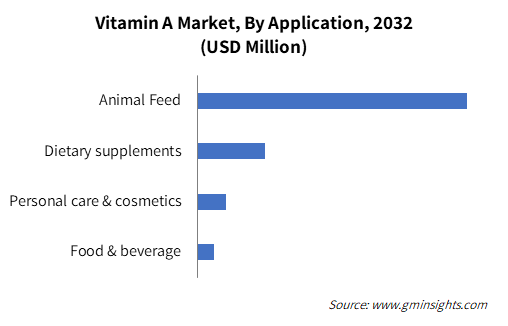Home > Food & Beverages > Nutraceuticals > Vitamins > Vitamin A Market
Vitamin A Market Analysis
- Report ID: GMI1765
- Published Date: Apr 2023
- Report Format: PDF
Vitamin A Market Analysis
Feed grade vitamin A market dominate the revenue share in 2022. All animals require vitamin A in their food. Vitamin A can be obtained in the food as a vitamin or as its precursor carotenoids, which are found in plants. The majority of vitamin A in animal feed comes from synthetic sources that are cost-effective to produce. Vitamin A acetate is commonly used in feed-grade vitamin A because it is more stable, however oily vitamin A acetate is frequently converted into dry powder. Vitamin A is especially vital for preventing growth problems, and its epithelial protection role is particularly crucial in older animals. As a result, the demand for vitamin A in the feed industry has increased. Additionally, key players such as BASF SE, Adisseo, and DSM are increasingly investing in the development of new vitamin-based products and expanding their presence into emerging markets.

The natural vitamin A market is expected to expand at faster CAGR between 2023 and 2032. Natural sources of vitamin A, also referred to as provitamin A, can be found in plant-based items including fruits and vegetables. The most common type of pro-vitamin A is beta-carotene, which is found in sweet potatoes, spinach, cabbage, swiss chard, parsley, and carrots.
The market for natural vitamin A is estimated will gain remarkable momentum during the forecast timeline, as more individuals understand its health benefits. The need for fortified foods and supplements should drive product penetration. Various governments are launching new campaigns to raise consumer awareness regarding fortified foods, which will accelerate the natural vitamin A market revenue.

The vitamin A market share from dietary supplements segment is predicted to exceed USD 175 million by 2032. Vitamin A is an important micronutrient for humans, which means it cannot be manufactured by the body and must be received through food. Dietary supplements (DSs) are increasingly popular around the world, and sales of DSs have risen dramatically in the aftermath of the coronavirus illness 2019 (COVID-19) in most nations. According to a survey by MDPI, the worldwide dietary supplement industry was valued at over USD 101.38 billion in 2018 and was set to quadruple that amount in 2020 (around USD 220.3 billion).

Asia Pacific vitamin A market is slated to rise substantially during the forecasted period. The region has been using fortification techniques for many years to lower the incidence of vitamin A deficiency. Sugar was selected as the main carrier for vitamin A fortification. The COVID-19 pandemic has made consumers in the region more sensitive toward their health. Apart from this, factors such as increasing population base and increasing consciousness towards health should fuel the consumption of dietary supplements that are fortified with vitamin A in the region.

